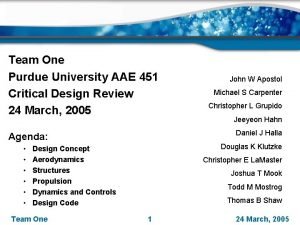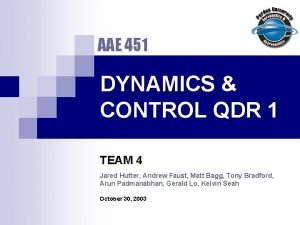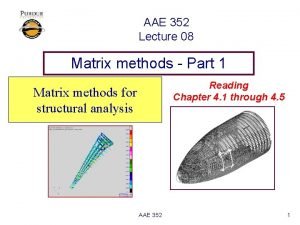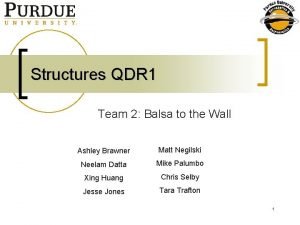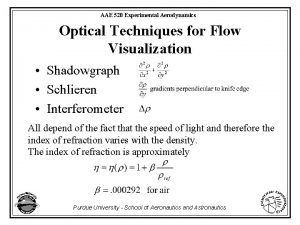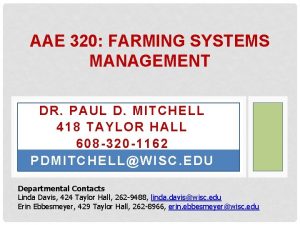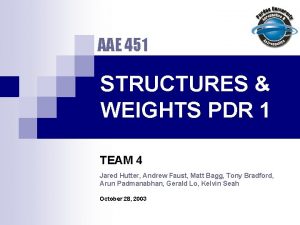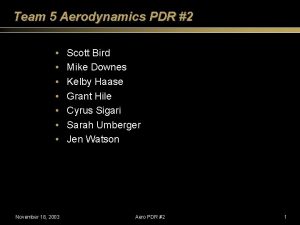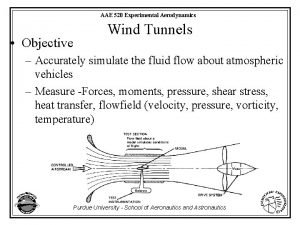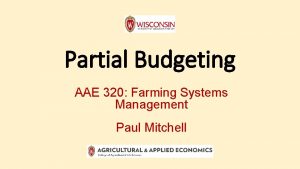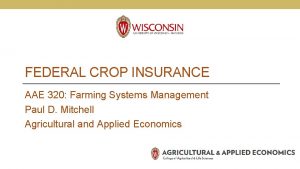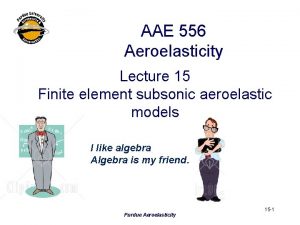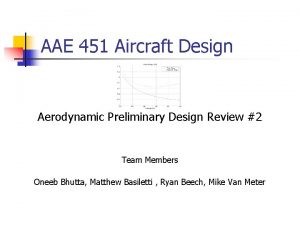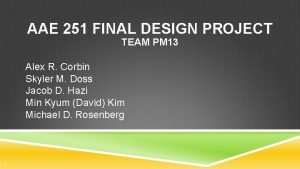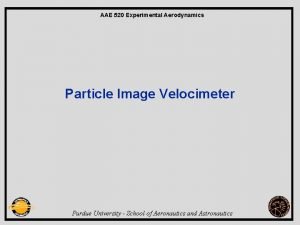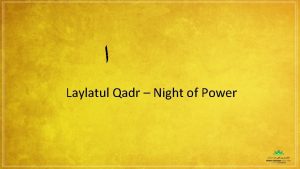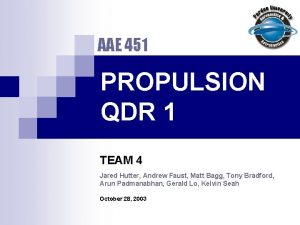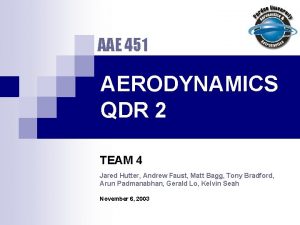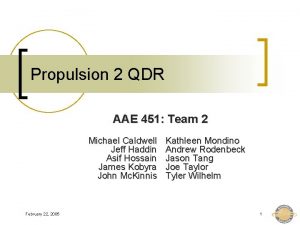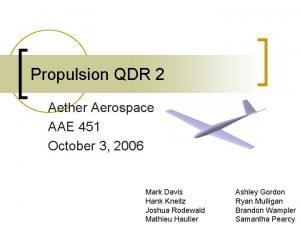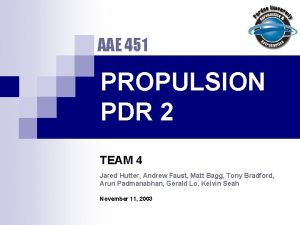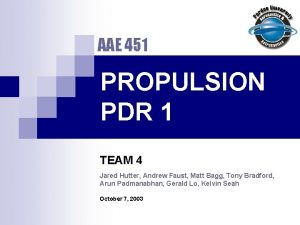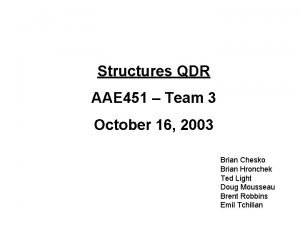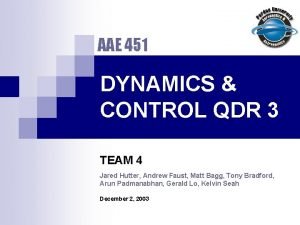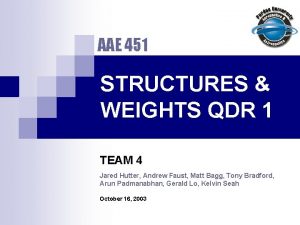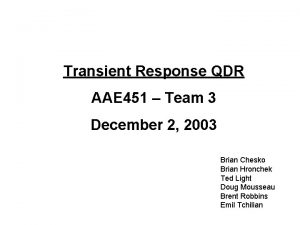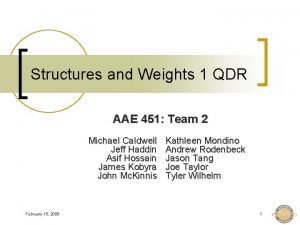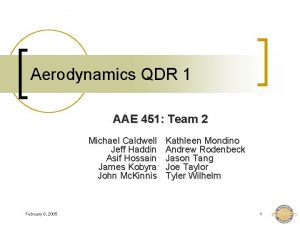AAE 451 PROPULSION QDR 2 TEAM 4 Jared















- Slides: 15

AAE 451 PROPULSION QDR 2 TEAM 4 Jared Hutter, Andrew Faust, Matt Bagg, Tony Bradford, Arun Padmanabhan, Gerald Lo, Kelvin Seah November 20, 2003

CONCEPT REVIEW Empennage Horizontal and Vertical Tails sized using modified Class 1 Approach (per D & C QDR 1) High Wing S = 34. 5 ft 2 b = 13. 1 ft, c = 2. 6 ft AR = 5 Twin Booms Avionics Pod 20 lb; can be positioned front or aft depending on requirements Twin Engine 1. 8 HP each 3 ft apart; 7. 3 ft from Wing MAC to HT MAC

OVERVIEW n Overview of Engine Used n Thrust Analysis n Propeller Selection, Analysis & Choice n Summary of Results n Follow-Up Actions

ENGINE CHOICE Engine Choice: Saito FA-100 n n Specifications: ¨ Weight: 20. 8 oz ¨ Bore: 29. 0 mm ¨ Stroke: 26. 0 mm ¨ Displacement: 1. 0 cu. in. ¨ Practical RPM: 2, 100 - 9, 300 ¨ Power: 1. 8 BHP @ ~9100 RPM ¨ Fuel Consumption Rate: 1 oz/min 9 $279. 9 at maximum RPM Source: http: //www. saitoengines. com

DRAG ANALYSIS & REQUIRED THRUST Span efficiency, e 0. 6 n performed for OEI condition n Aspect Ratio, AR 5 n Lift Coefficient, CL 0. 98 n Induced Drag Coefficient, CDi Parasitic Drag Coefficient, CD 0 Drag Coefficient, CD = CD 0 + CDi n n 0. 102 0. 06 0. 162 n Wing Area, S 34. 46 ft 2 Velocity = 1. 2 Vstall = 1. 2 28 ft/sec = 33. 6 ft/sec Density, ρ = 0. 002377 slug/ft 3 n Drag = 7. 5 lbf n n

DRAG ANALYSIS & REQUIRED THRUST (continued) n n Drag = 7. 5 lbf Flight Path Angle, = 0. 5 Weight = 54. 5 lbf Thrust = Drag + Weight*sin( ) = 8 lbf V L T D W

PROPELLER ANALYSIS PROCEDURE n Ensured that Gold. m was accurate. n Modified Gold. m to incorporate actual propeller chord distributions for specific propellers. n Plotted results to finalize propeller choice. n Twin engine performance characteristics.

BELIEVABILITY CHECK Specifications n First Place Engine, FPE 1. 3 ci DISPLACEMENT http: //www. fpengines. com WEIGHT 43. 2 ounces (including muffler) THRUST 10 lbs @7, 400 rpm RPM RANGE 2, 000 to 7, 400 rpm RECOMMENDED PROP n 1. 3 cubic inches (21 cc) 16 x 8 Gold. m results using a 16” x 8” propeller: ¨ Model Propeller Geometry: Tstatic = 9. 9 lbs @ 7400 RPM ¨ Zinger Propeller Geometry: Tstatic = 11. 9 lbs @ 7400 RPM Propeller Geometry Source: http: //www. ace. gatech. edu/experiments 2/6514/aircraft/fall 02/propeller. htm

TWIST DISTRIBUTION

PROPELLER ANALYSIS

lbf PROPELLER ANALYSIS

PROPELLER ANALYSIS

ENGINE PARAMETERS n Single Engine Flight (V = 33. 6 ft/s) n Twin Engine Flight (V = 60 ft/s) ¨ CP = 0. 0274 ¨ CP = 0. 0185 ¨ CT = 0. 0619 ¨ CT = 0. 0337 ¨ J = 0. 1662 ¨ HP = 1. 74 @ 9100 RPM ¨ HP = 0. 54 @ 7000 RPM ¨ = 37. 5% ¨ = 70% ¨ T = 10. 7 lbf ¨ T = 3. 44 lbf/engine = 6. 88 lbf

FOLLOW-UP ACTIONS n Contact engine manufacturer for further engine details n Finalize fuel feed system

QUESTIONS?
